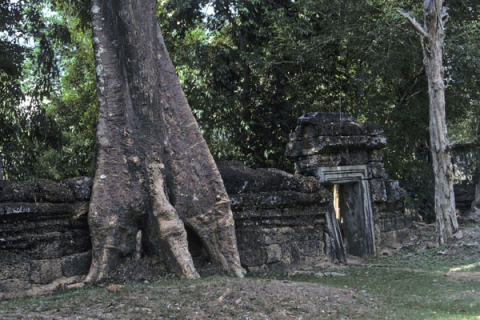
852094800
Stone wall and doorway overgrown by forest at Ta Prohm site at Angkor
A leaning stone wall and doorway are overgrown by forest at Ta Prohm, a small unconserved site near Angkor Thom. A huge tree at left is seen growing into the side of the temple wall.
Ta Prohm was built as a double-moated, royal monastery during the reign of Jayavarman VII at the end of the twelfth century. As a Mahayana Buddhist, the king dedicated the monument to his mother envisioned as a "bodhisattva" or saint of compassion.
The images of Buddha were removed from the temple by later rulers, probably including Jayavarman VII's successor, Jayavarman VIII, who was a Hindu. During this period in Southeast Asian history, Hindu gods and Buddha images were often worshipped side-by-side although some rulers showed clear preferences.
When French explorers first discovered the overgrown buildings at the ancient capital of Angkor in the late 1800s, much of the area was completely covered by forest. In particular, the roots of strangler figs, kapok, and banyan trees aggressively encompassed the Angkor structures.
This small site was deliberately left unconserved by French archaeologists to create a sharp contrast with their painstaking reconstruction of the temples in the Angkor Wat complex. At present, the temple is only conserved to prevent further building collapses and to clear passage for visitors. Even these two goals require considerable labor and forest management.
Creative Commons BY-NC-SA
 852094800
852094800